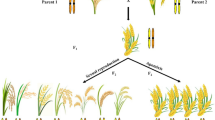Summary
Seeds of tetraploid Solanum acaule (2n=48) and diploid S. bulbocastanum (2n=24) were germinated in petri-dishes on filter paper soaked in 0.3% colchicine. An additional treatment with 0.3% colchicine was applied one month after sowing at four successive days in the axils of the cotyledons of the seedlings. S. acaule appeared much more sensitive to colchicine (14 surviving seedlings from 500 seeds) than S. bulbocastanum (109 surviving seedlings from 450 seeds). Six S. acaule plants with 2n=96 chromosomes were obtained against 38 S. bulbocastanum plants with 2n=48 chromosomes.
The ploidy level in each of the three germ layers L1, L2, L3 was determined in 113 plants of S. bulbocastanum and the following results were obtained. Four of the eight possible ‘ploidy types’ were detected, viz 2x-2x-2x (72 plants), 4x-2x-2x (3 plants), 2x-4x-4x (9 plants) and 4x-4x-4x (29 plants). Doubling the number of chromosomes resulted in a highly significant increase of the number of chloroplasts in the guard cells of stomata and a greatly significant decrease in the proportion of trimerous pollen, male fertility and leaf index. The variability for all characters studied, except for leaf index, was clearly lowest in the 2x-2x-2x group. All plants with a 2x-L2 were highly male fertile and self-incompatible, also in the three bud stages tested. Male fertility of the plants with 4x-L2 varied greatly: 12 plants had more than 90% stainability, 5 plants must be considered male sterile. All non-sterile plants with 4x-L2 were found to be self-compatible, pointing to a gametophytic system of incompatibility in S. bulbocastanum.
Similar content being viewed by others
References
Dionne L. A., 1963. Studies on the use of Solanum acaule as a bridge between Solanum tuberosum and species in the series Bulbocastana, Cardiophylla and Pinnatisecta. Euphytica 12: 263–269.
Frandsen N. O., 1967. Chromosomenverdopplung und Chimärenbildung nach Colchicinbehandlung haploider Kartoffelsamen. Eur. Potato J. 10: 1–15.
Frandsen N. O., 1968. Die Plastidenzahl als Merkmal bei der Kartoffel. Theor. and Appl. Genet. 38: 153–167.
Hermsen J. G. Th., 1966. Crossability, fertility and cytogenetic studies in Solanum acaule x Solanum bulbocastanum. Euphytica 15: 149–155.
Lebedeva N. A., 1966. Solanum bulbocastanum Dun. A promising species for potato selection. Sovjet Genetics 2: 47–50.
Livermore J. R. & Johnstone F. B., 1940. The effect of chromosome doubling on the crossability of S. chacoense, S. jamesii and S. bulbocastanum with S. tuberosum. Am. Potato J. 17: 170–173.
Najčevska C. M. & Speckmann G. J., 1968. Numbers of chloroplasts and pollen grain pores in diploid and tetraploid varieties of some Trifolium species. Euphytica 17: 357–362.
Author information
Authors and Affiliations
Rights and permissions
About this article
Cite this article
Hermsen, J.G.T., De Boer, A.J.E. The effect of colchicine treatment on Solanum acaule and S. bulbocastanum; A complete analysis of ploidy chimeras in S. bulbocastanum . Euphytica 20, 171–180 (1971). https://doi.org/10.1007/BF00056077
Received:
Issue Date:
DOI: https://doi.org/10.1007/BF00056077




